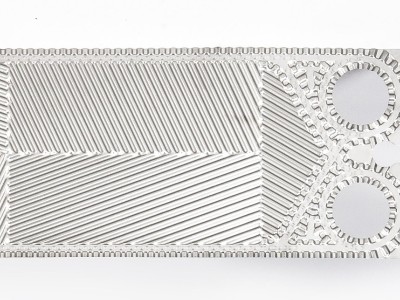Plate heat exchanger corrugated plate to prevent deformation under pressure
Plate heat exchanger is a highly efficient, energy-saving heat transfer equipment with high heat transfer coefficient, compact structure, less consumables, diverse forms, easy maintenance and many other advantages of gradually expanding applications have been widely used in machinery, electric power, metallurgy, chemical industry, textile, beverage, urban heating and other industries and fields show strong competitiveness.
Plate heat exchanger to metal plate (general thickness of 0.5 ~ 1.0mm) for the heat transfer element by stainless steel, industrial titanium or other pure The plate of material is pressed from the plate. Usually use the mold to press the plate into a variety of groove-shaped or corrugated shape to increase the rigidity of the plate to prevent deformation when the plate is pressed and also enhance the The degree of turbulence of the fluid increases the heat transfer area. Each plate has a hole in the corner of each plate. The gaskets act to allow or prevent fluid from entering the passage between the plates.
If several plates are arranged in sequence on a support according to the heat transfer requirements and the fixed and movable clamping plates are pressed together by the clamping screw on the adjacent The fluid channels are formed between the plates of the heat exchanger with the help of orifices and gaskets at the corners of the plates. Each size of Airead plate, with at least two plate types, uses thermal mixing technology to combine heat transfer and pressure drop of the heat exchanger. Keeps it running at the optimal operating point. Internal bypass, dual-runner technology and unequal flow cross-sectional assemblies provide the perfect solution for applications with large differences in media flow between the two sides. ARD plate heat exchanger has AB series, AM series, AL series, AP series, AS series and several other series of more than 100 kinds of heat exchanger. Plate Type. All models have deep corrugated, shallow corrugated, large angle, small angle, etc., to ensure that different users to meet the needs of the special conditions can according to the Users need to design and manufacture them specifically.
In metal manufacturing, oil-water emulsions are used as refrigerants and lubricants. Oil-water emulsions can be reused several times and are expensive to recycle, but after a certain period of time, they must be replaced with new ones. of materials up.
The goal of wastewater treatment is to share the oily material out of the water phase, and to minimize the contaminants in the water so that it can be discharged into the discharge in a treatment plant or returned to the plant for reuse; and the oily component should be highly concentrated to facilitate transfer to, for example, an incineration plant. . A heat sharing process for evaporation units may be well suited for this task.

Process Description
The wastewater is first separated from the coarse solids and free oil, and the wastewater, after being filtered again, will flow into an evaporation unit. In a set of descending membrane pre-evaporators, the wastewater is concentrated to about 30% of the attempt. This part of the plant is heated by an energy-efficient mechanical steam re-compressor. In a forced circulation evaporator, the wastewater is concentrated to a high degree. In most cases, the evaporation condensate still contains an oil component, so that before discharge to wastewater treatment equipment or reuse, it must be for further processing.
Related information
- Many people were killed in the Aegean earthquake. How can seawater plate heat exchangers be accident-free?
- Is the plate heat exchanger for juice cooling imported or domestic? Your focus is simply wrong
- What to look for when using a plate heat exchanger
- What is the mystery of the industrial plate heat exchanger custom made that many people are looking for?
- Does semi welded plate heat exchanger real expensive?
- Causes of heat exchanger gasket aging
Relevant article
- 1
- Can plate heat exchanger be directly used for feed water heating or cooling?
- Why the heat transfer efficiency of plate heat exchangers in the heating industry is low
- How to determine the size and angle of plate heat exchanger plate?
- What is the proportion of pressure drop in the selection of plate heat exchanger?
- Why do we recommend food grade plate heat exchanger for beer brewing and fermentation? What should we pay attention to?
- What is the difference between the hanging holes on the plate of plate heat exchanger?
- What are the applications of plate and shell heat exchanger in the field of petroleum refining
- What is the key to the manufacture of plate heat exchangers with small temperature differences?
- How to descale the plate heat exchanger? What problems should be paid attention to during use?
Latest information
- Heat station supporting plate heat exchanger installation is a technical work, these points should be noted
- Sulfuric acid and other corrosive media for industrial plate heat exchanger requirements are what
- Simple and effective chemical cleaning method of coal chemical plate heat exchanger, can effectively improve efficiency
- A high-quality petrochemical plate heat exchanger in the production of what to consider
- These causes of chemical plate heat exchanger gasket aging you may not know
- Chemical plant plate heat exchanger, sulfuric acid cooling needs attention
- High-end plate heat exchanger customization, specifically for your special working conditions
- The working principle of gasket type industrial plate heat exchanger and the scenarios of its use are worth knowing in depth
- Still worrying about the wholesale price of industrial plate heat exchangers? An article to make you no longer tangled
- The original lubricant in the chemical plate heat exchanger plays so many roles!








